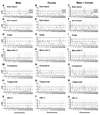Aortic arch curvature and atherosclerosis have overlapping quantitative trait loci in a cross between 129S6/SvEvTac and C57BL/6J apolipoprotein E-null mice
- PMID: 20133902
- PMCID: PMC2848914
- DOI: 10.1161/CIRCRESAHA.109.207175
Aortic arch curvature and atherosclerosis have overlapping quantitative trait loci in a cross between 129S6/SvEvTac and C57BL/6J apolipoprotein E-null mice
Abstract
Rationale: Apolipoprotein E-null mice with a 129S6/SvEvTac strain background (129-apoE) develop atherosclerotic plaques faster in the aortic arch but slower in the aortic root than those with a C57BL/6J background (B6-apoE). The shape of the aortic arch also differs in the 2 strains.
Objective: Because circulating plasma factors are the same at both locations, we tested the hypothesis that genetic factors affecting vascular geometry also affect the location and extent of atherosclerotic plaque development.
Methods and results: Tests on the F2 progeny from a cross between 129-apoE-null and B6-apoE-null mice showed that the extent of atherosclerosis in the aortic arch is significantly correlated in males, but not in females, with the shape of arch curvature (r=0.34, P<0.0001) and weakly with the arch diameter (r=0.20, P=0.02). Quantitative trait locus (QTL) analysis identified 2 significant peaks for aortic arch lesion size on chromosome 1 (105 Mb, LOD=5.0, and 163 Mb, LOD=6.8), and a suggestive QTL on chromosome 15 (96 Mb, LOD=4.7). A significant QTL for aortic root lesion size was on chromosome 9 (61 Mb, LOD=6.9), but it was distinct from the QTLs for arch lesion size. Remarkably, the QTLs for susceptibility to atherosclerosis in the arch overlapped with a significant QTL that affects curvature of the arch on chromosome 1 (121 Mb, LOD=5.6) and a suggestive QTL on chromosome 15 (76 Mb, LOD=3.5).
Conclusions: The overlapping QTLs for curvature of the aortic arch and atherosclerosis support that the ontogeny of the aortic arch formation is a potential risk factor for atherosclerosis.
Figures




Similar articles
-
Genetic architecture of atherosclerosis dissected by QTL analyses in three F2 intercrosses of apolipoprotein E-null mice on C57BL6/J, DBA/2J and 129S6/SvEvTac backgrounds.PLoS One. 2017 Aug 24;12(8):e0182882. doi: 10.1371/journal.pone.0182882. eCollection 2017. PLoS One. 2017. PMID: 28837567 Free PMC article.
-
Identification of aortic arch-specific quantitative trait loci for atherosclerosis by an intercross of DBA/2J and 129S6 apolipoprotein E-deficient mice.PLoS One. 2015 Feb 17;10(2):e0117478. doi: 10.1371/journal.pone.0117478. eCollection 2015. PLoS One. 2015. PMID: 25689165 Free PMC article.
-
Relationship between hemodynamics and atherosclerosis in aortic arches of apolipoprotein E-null mice on 129S6/SvEvTac and C57BL/6J genetic backgrounds.Atherosclerosis. 2012 Jan;220(1):78-85. doi: 10.1016/j.atherosclerosis.2011.10.020. Epub 2011 Oct 21. Atherosclerosis. 2012. PMID: 22078246 Free PMC article.
-
Genetic basis of atherosclerosis: insights from mice and humans.Circ Res. 2012 Jan 20;110(2):337-55. doi: 10.1161/CIRCRESAHA.110.230854. Circ Res. 2012. PMID: 22267839 Free PMC article. Review.
-
Genetic and genomic insights into the molecular basis of atherosclerosis.Cell Metab. 2007 Sep;6(3):164-79. doi: 10.1016/j.cmet.2007.07.001. Cell Metab. 2007. PMID: 17767904 Free PMC article. Review.
Cited by
-
Atherosclerosis in Different Vascular Locations Unbiasedly Approached with Mouse Genetics.Genes (Basel). 2020 Nov 28;11(12):1427. doi: 10.3390/genes11121427. Genes (Basel). 2020. PMID: 33260687 Free PMC article. Review.
-
Differences in health status affect susceptibility and mapping of genetic loci for atherosclerosis (fatty streak) in inbred mice.Arterioscler Thromb Vasc Biol. 2012 Oct;32(10):2380-6. doi: 10.1161/ATVBAHA.112.255703. Epub 2012 Jul 26. Arterioscler Thromb Vasc Biol. 2012. PMID: 22837474 Free PMC article.
-
Quantitative trait loci affecting atherosclerosis at the aortic root identified in an intercross between DBA2J and 129S6 apolipoprotein E-null mice.PLoS One. 2014 Feb 20;9(2):e88274. doi: 10.1371/journal.pone.0088274. eCollection 2014. PLoS One. 2014. PMID: 24586312 Free PMC article.
-
The Genetic Elements of the Obesity Paradox in Atherosclerosis Identified in an Intercross Between Hyperlipidemic Mouse Strains.Int J Mol Sci. 2025 Apr 29;26(9):4241. doi: 10.3390/ijms26094241. Int J Mol Sci. 2025. PMID: 40362477 Free PMC article.
-
Role of shear stress-induced red blood cell released ATP in atherosclerosis.Am J Physiol Heart Circ Physiol. 2025 Apr 1;328(4):H774-H791. doi: 10.1152/ajpheart.00875.2024. Epub 2025 Feb 21. Am J Physiol Heart Circ Physiol. 2025. PMID: 39982440 Free PMC article.
References
-
- Malek AM, Alper SL, Izumo S. Hemodynamic shear stress and its role in atherosclerosis. JAMA. 1999;282:2035–2042. - PubMed
-
- Friedman MH, Deters OJ, Mark FF, Bargeron CB, Hutchins GM. Arterial geometry affects hemodynamics. A potential risk factor for athersoclerosis. Atherosclerosis. 1983;46:225–231. - PubMed
-
- Zhang SH, Reddick RL, Piedrahita JA, Maeda N. Spontaneous hypercholesterolemia and arterial lesions in mice lacking apolipoprotein E. Science. 1992;258:468–471. - PubMed
Publication types
MeSH terms
Substances
Grants and funding
LinkOut - more resources
Full Text Sources
Medical
Molecular Biology Databases
Miscellaneous

